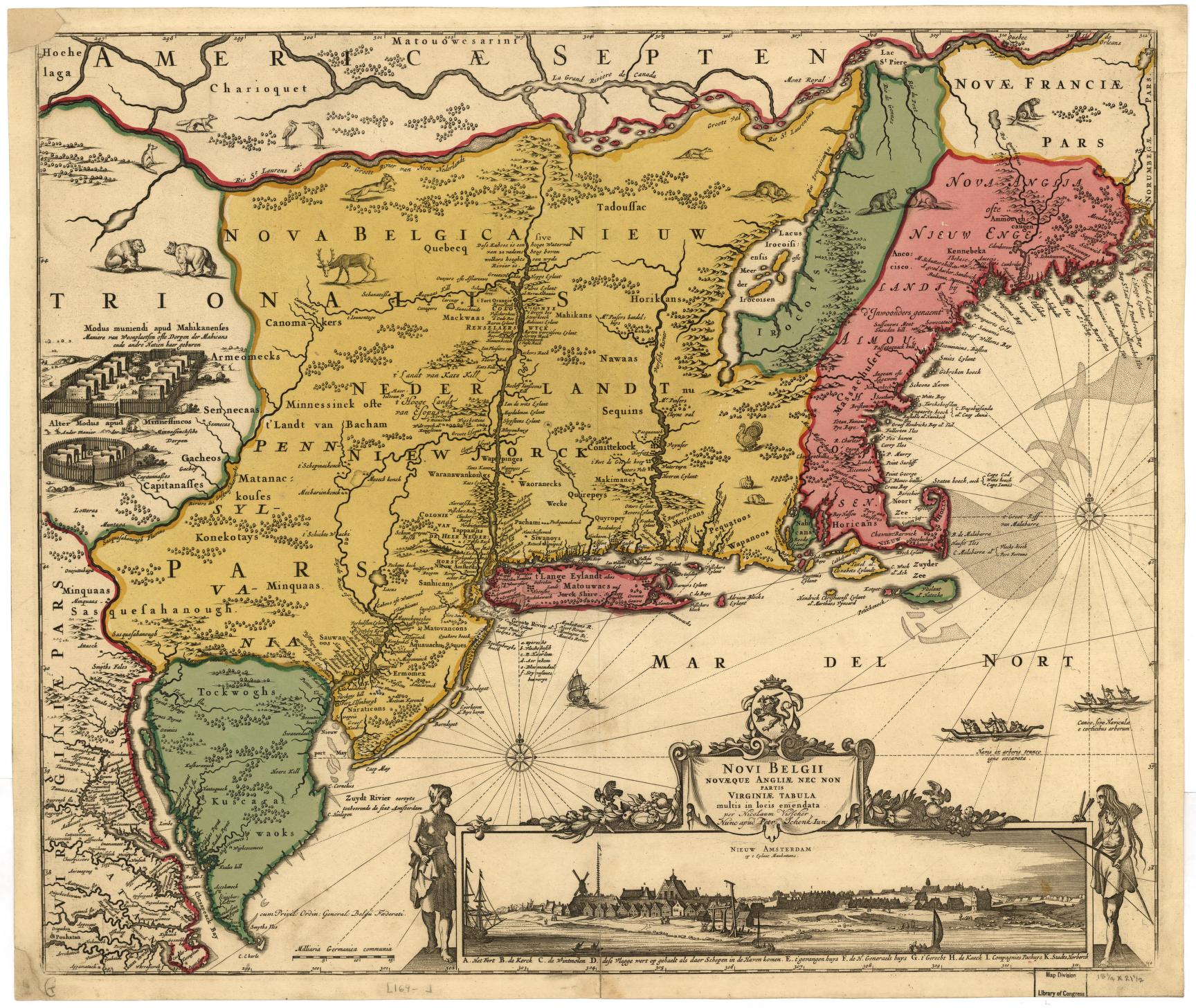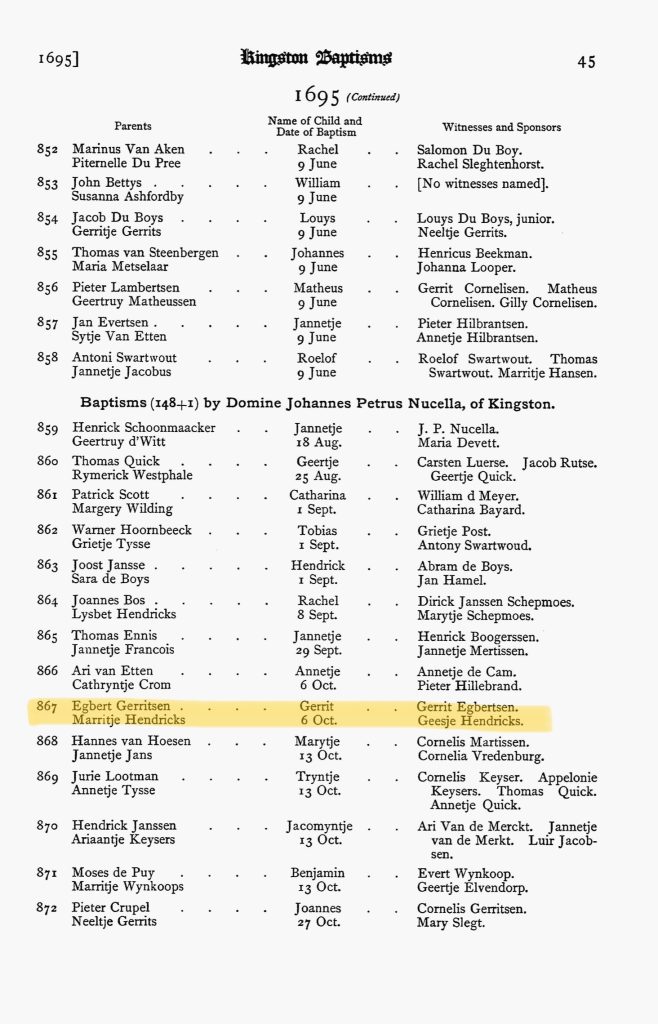
Gerrit Egbertsen was born during a period historically referred to as the “Dutch Golden Age,” a time of colonial expansionism and national pride.
But as he entered his teenage years, it was increasingly a time of uncertainty and growing tension with the English.
In the 1650s, the Dutch West India Company was under pressure to increase immigration to New Netherland. England’s colonies in the New World were growing at a much faster rate, which created a sense of unease among the Dutch over how to maintain their territorial claims.[1]
The solution was a new financial incentive. In 1656, the Dutch West India Company announced that “all mechanics and farmers who can prove their ability to earn a living here shall receive free passage for themselves, their wives and children.” [1]
Not long after reaching adulthood, Gerrit took advantage of the offer.
In 1660, Gerrit was 19 years old and working as a farmer’s servant in Meppel, the rural city where he grew up. Economic opportunities were limited, and his father had died several years earlier.
This is the life he chose to leave behind when he boarded a ship called De Bonte Koe (“The Spotted Cow”) in Amsterdam.
On April 15, 1660, he set sail for New Amsterdam (present-day New York City).[2]
Almost everything we know about Gerrit’s life in the Netherlands comes from the ship’s passenger manifest:
“Gerrit Egbertsz, farmer’s servant, from Meppel”
While some other passengers are listed as having a wife and children with them, Gerrit is not. He appears to have made the voyage alone. It is likely that Gerrit came with nothing more than the clothes on his back, looking for work as a farmer.

The manifest lists 62 passengers and 20 crew in total on the 1660 voyage. It is unknown which other passengers Gerrit interacted with while on board the ship, but two fellow passengers are worth mentioning as they may have shaped Gerrit’s path once he arrived.
The first is Roeloff Swartwout, a prominent merchant in New Netherland. Swartwout was on a return voyage to New Netherland after meeting with the Lords Directors of the Dutch West India Company in Amsterdam. In the meeting, the Lords Directors designated Swartwout the new schout (magistrate) of the settlement at present-day Kingston, New York. They sent Swartwout back to New Amsterdam with a letter directing Governor Peter Stuyvesant to recognize his authority over the settlement.[3]
The second is Aldert Heymans Roosa, a wealthy agriculturalist from Gelderland bringing his family to New World. Upon arriving in New Amsterdam, Roosa followed Swartwout to Kingston and, in 1662, the two of them were instrumental in founding the settlement at present-day Hurley, New York — where our ancestors lived when they adopted the “Constable” surname.[4]
It is unclear whether Gerrit immediately followed Swartwout and Roosa up the Hudson River upon arrival. In fact, he may not have settled there until some years later.
In 1673, a “Garret Egberts (Dutch)” appears on a census in present-day Elizabeth, New Jersey.[5] The baptismal records at the Dutch Reformed Church in New Amsterdam list a “Gerrit Egbertszen” as the father of a boy named Pieter baptized in in 1674.[6]
It is believed that at some point in the 1660s, Gerrit also fathered a son named Egbert, who later became the first “Constable.” It is unclear where Gerrit was living at the time, as record of Egbert’s baptism has yet to be found (if it exists at all).
Regardless, Gerrit and his family appear to have reached the Hudson Valley no later than 1687. He appeared on a census of Ulster County residents taken Sept. 1 of that year[7] and was included on a 1687 “List of Soldiers in Esopus,” another name for the settlement at Kingston.[8] He served in Captain Tomas Gersone’s Company.
In 1695, Gerrit was present at the Old Dutch Church in Kingston with his son, Egbert, for the birth of his grandson, Gerrit.[9]
This is the last time Gerrit, our first ancestor in the New World, appears on record, though he may well have lived into the early 1700s before passing.

Now, is it possible that the late-1600s Gerrit Egbertsen in these Ulster County, New York, records is a different person than the mid-1600s Gerrit Egbertsen who sailed on The Spotted Cow? Or the ones who appeared in the New Amsterdam and Elizabeth Town records? Of course.
But consider the historical context. The total Dutch population in New Netherland was estimated to be quite small — about 9,000 people around the time the English seized control in 1664.[10] The English had four times as many settlers in the New World at that point in time.[1]
And Dutch immigration to the New World came to a halt after the English victory in 1664, and did not resume in any meaningful way until after the American Revolution.[11] This essentially eliminates the possibility of an arrival after 1664.
Therefore, it is very possible that there was only one Gerrit Egbertsen of Dutch descent living in the New World in the mid-to-late 1600s.
With the information available, it is currently believed that the Gerrit Egbertsen who came to the New World on The Spotted Cow in 1660 was also the father of the person we know as Egbert Gerritsen Constapel — the founding father of the Dutch Constable family.
Citations
- The United States Of America And The Netherlands (2012). By Prof. George M. Welling, University Groningen. “Nieuw Nederland.” View the original source.
- New World Immigrants: A Consolidation of Ship Passenger Lists and Associated Data from Periodical Literature. (1979). Edited by Michael Tepper. United States: Genealogical Publishing Company. View the original source.
- New Netherland: A Dutch Colony in 17th century America (2005). By Jaap Jacobs. View the original source.
- The Roosa Family of Ulster and Dutchess Counties, New York (1900). By Holdridge Ozro Collins. New York Genealogical and Biographical Society, Vol. 31, Issue 3. View the original source.
- History of Elizabeth, New Jersey (2010). By Edwin Hatfield. Pg. 159. View original source.
- Baptisms from 1639 to 1730 in the Reformed Dutch Church, New York. Pg. 115. View original source.
- Recorded as “Gerritt Agbortsin”. The Documentary History of the State of New-York. By E. B. O’Callaghan. Pg. 174. View the original source.
- Recorded as “Gerett Egbarson”. Annual Report of the New York State Historian (1898). Vol. 3. Pg. 449. View the original source.
- Kingston Baptismal Register, 1660-1809. Pg. 45. View the original source.
- National Parks Service. “The Rise and Fall of New Netherland.” View the original source.
- The United States Of America And The Netherlands (2012). Prof. George M. Welling, University Groningen. “The Dutch In British America.” View the original source.